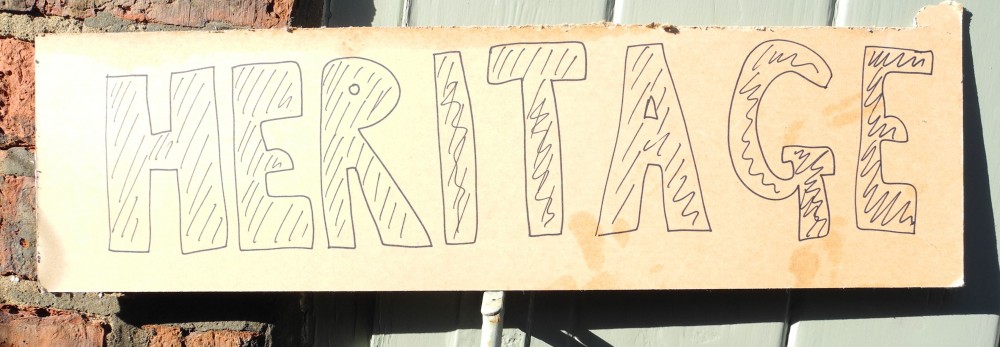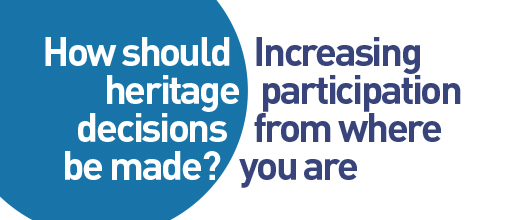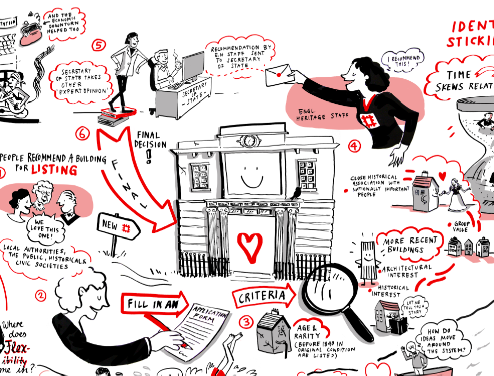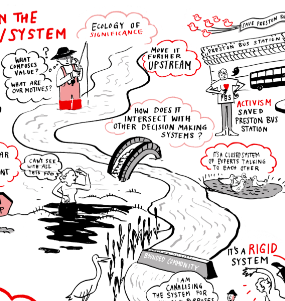Since October last year when we – with 15 others – all met at MadLab and created the drawing below, the ‘How should decisions about heritage be made?’ research team have been off in different configurations and different parts of the UK working on different mini projects as part of our three Inquiry strands. Following our first co-analysis workshop and before we hit the Connected Communities Festival in Cardiff, we thought we’d take a quite pause for reflection and do a bit of an update. You can see an overview of the project so far in the booklet we’ve produced for the Festival. Heritage Decisions booklet
Our overall research aims and questions were:
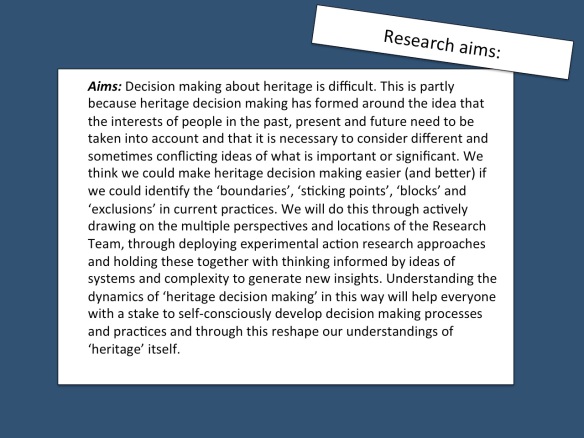
The research aims we devised in Phase 1
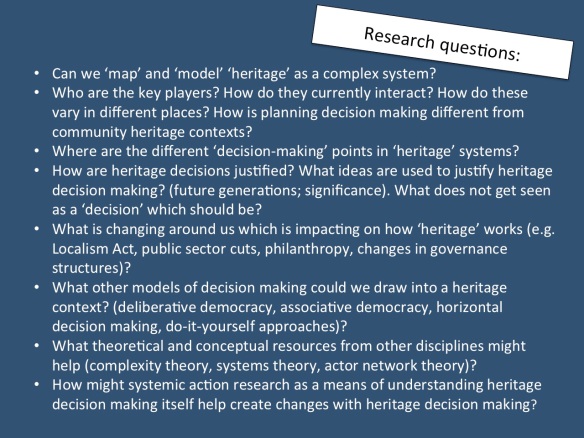
Our research questions
Following our Manchester workshop – where we tested our ideas with 15 other people – we’ve been working on our three Inquiry strands.

The illustration we came up with at the Manchester workshop to explore a ‘systemic’ approach to heritage decision making
Inquiry Strand 1: ‘from the inside’
Our Inquiry 1 was focused on four of the practitioners in the team – Alex Hale RRCHAMS); Jenny Timothy (Conservation team, Leicester City Council), Mike Benson (Bede’s World) and Danny Callaghan (Potteries Tile Trail) – having a chance to reflect on their own places and practices with other people they work with.
Some of this work is still a work-in-progress, however, a lot of activity has already taken place. For example, Rebecca Madgin (University of Glasgow) is currently conducting interviews with key people related to RCAHMS/ScARF’s From Source to Sea project. Rebecca is also working with Jenny Timothy (Leicester City Council) on the analysis of a specific planning and conservation project in Leicester. The following two summaries aim to give a flavour of what we have been working on:
Source to Sea
Alex got creative with Lego and other things in Lanark as a way of engaging local people in mapping the Clyde and it’s significance to them. A pop-up event in Lanark on Saturday 7th December 2013, gave both the HLF-funded Clyde and Avon Landscape partnership and the Royal Commission on the Ancient and Historical Monuments of Scotland an exciting opportunity to engage with local people and to find out what aspects of their surroundings they are really interested in. The event aimed to create a neutral space on the Lanark High Street, in the Tolbooth, where people could explore and map their connections to the landscape around them, which has been shaped by the River Clyde.
The workshop event used a range of techniques to enable people, from Lego to community mapping techniques, to illustrate, articulate and describe their connections to the surroundings, in particular the River Clyde and its course. The event enabled people to share ideas and discuss opportunities, in an informal environment, about how they want to contribute to the understanding and valuing of the local historic environment, through the forthcoming Source to Sea programme. Rebecca Madgin (University of Glasgow) is now working with Alex to reflect on how this project might illuminate decision-making processes.
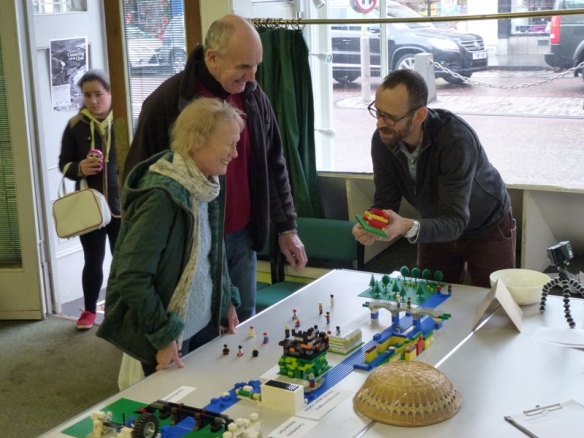
Lanark residents discuss their views of the Clyde with Alex Hale
The Potteries Tile Trail
Danny Callaghan (Independent Consultant), Karen Brookfield (Heritage Lottery Fund) and Helen Graham (University of Leeds) have met three times in The Potteries (Stoke-on-Trent) during the last 12 months. Our study visits and conversations coalesced around the following interrelated themes:
• Heritage Lottery Fund – influence and support for grassroots led activity
• Activist, DIY and community heritage
The starting point for this inquiry was a project called The Potteries Tile Trail – a community and crowd sourced virtual collection of tiles and architectural ceramics that can be found in buildings and public spaces throughout Stoke-on-Trent. The lead partner was the Tiles and Architectural Ceramics Society and it was funded by an HLF All Our Stories grant. Danny developed the proposal and delivered the project. Karen had strategic responsibility for the All Our Stories programme at a national level on behalf of HLF. This created a fascinating opportunity to explore and reflect on the programme from both macro and micro perspectives.
HLF have played an important role in encouraging and enabling grassroots led heritage activity over the last 20 years. Danny and Helen both identified valuable projects that simply would not have happened without the support of HLF. Many activist and community-led projects have been made possible by the HLF via small grant programmes such as All Our Stories.
Danny and Helen have both played facilitator roles that involve working across professional and community boundaries. A new breed of heritage activist has evolved and is often behind community-led projects and related funding bids. Key characteristics include passion, energy and an instinct for taking action about things that matter (to them) – sometimes – regardless of any kind of formal ‘permission’. A key skill is the ability to create new networks for action or a coalition of the willing, (as Danny calls it). This involves identifying key individuals both within and without institutions with a shared interest and finding ways to work together. If needed it is also about taking positive direct action and cutting through official processes to make things happen.
Strand 2: ‘experimenting’ at the Science Museum / Collaboratively collecting electronic music
Tim Boon (Science Museum) has been working in a research cluster with Richard Courtney (University of Leicester) and Helen Graham (University of Leeds). Since December 2013, this experimental project has collaborated with a group of musicians and electronic music fans David Robinson, John Stanley and Martin Swann who were all involved in the Science Museums’ collaborative Oramics exhibition, and Jean-Philippe Calvin from the Royal College of Music.
Over six sessions, the group have worked together explore two dimensions. The first has been the more practical task of working out how to recommend items for the Science Museum to collect, and five cases-in-principle for specific electronic instruments have now be accepted by the Museum’s collections board. The group collaborated on a partnership event called Synthesizer Bingo as part of Science Museum Lates. This involved each group member making a 1 minute ‘pitch’ about which synthesizers should be acquired by the Science Museum and why. The audience was then asked to vote for the one they felt had the strongest case for inclusion. The second aspect of the project has been to use first task as a means of exploring the political and philosophical questions raised by institution’s decision making about collecting material culture. Key issues that have emerged to date include:
• How do certain collections suggest their own communities of interest as decision-making constituencies?
• How might the ‘future’ of material culture be seen in its use rather than its protection?
Strand 3: ‘From the inside’
York: Living with History
The York-based contingent – Martin Bashforth (York’s Alternative History), Peter Brown (York Civic Trust) with Helen Graham – generated a project termed ‘living with history’ aiming as exploring ‘heritage’ and its decision making within the complexities of whole city. We’ve been asking:
• How are decisions about how to manage York’s heritage and history made?
• Who makes these decisions and what factors influence their decision-making?
• What is known about how ‘heritage’ intersects with other policy initiatives and areas? What is the relationship between heritage, tourism, ‘economic development’ and poverty? How does the medieval beauty of York affect the cost of housing?
• Which histories get counted in heritage decision making and which don’t? (e.g. Local Plan Heritage Topic Paper). What kinds of histories of York are not often publically recognized? How might richer understandings of York’s past help us work together to imagine York’s future?
• What might a more ‘democratic’ decision-making process look like? How might individual and group’s knowledge and passion become connected with institutional and policy decision-making? How might more connected approaches in turn help illuminate further how ‘history’ and ‘heritage’ affects York?
Since beginning a number of other people have become directly involved in driving the project. Paul Furness, local and radical historian and Lianne Brigham and Richard Brigham, who are administrators for the York Past and Present facebook group.
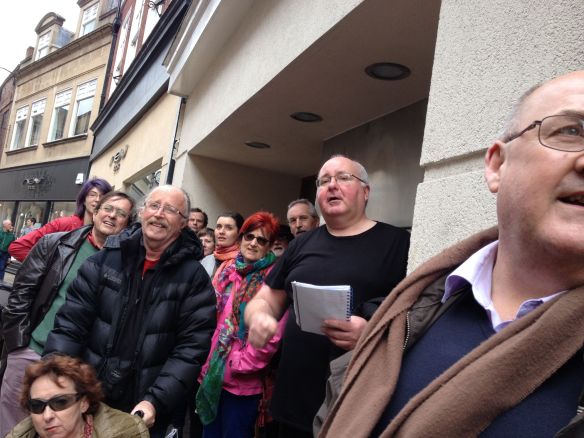
Paul Furness leads one our alternative history walks to open up debate about heritage and the city.
Together we’ve been creating a range of different spaces for explore these issues working up from:
1 to 1 conversation (people who were interested, meeting for a cup of tea)
Stalls in public spaces
Live Inquiry drops Ins at the Library
History menus in Jorvik Café
Social media and media
Walks/ history events
Public events focused around key forthcoming ‘decisions’ (Stonebow House; Castle Area)
A key principle of this – in keeping with our systemic thinking and systemic action research perspective – has been to try and make space for different perspectives, cross boundaries and create conversations and connections between people who wouldn’t usually meet.
A key finding so far has been enabled by the systemic thinking approach. We noted through the conversations, stalls and drop ins the strong sense of decision makers being an anonymous ‘they’ and decision-making processes as mysterious and transparent. At the same time, in the conversations with decision makers (professional and elected), there is an equally strong sense that everything is transparent and it’s easy to get involved (as it can be if you look in the right place) and feel, like public servants UK-wide, somewhat under attack and suffering from a lack of productive engagement from the public.
Yet one very productive way forward at reimagining the connection between interest, knowledge and dynamism in York and official decision making came out of one of the project’s Live Inquiry Drop Ins. Lianne and Richard were there, as were a number of other people who’d heard about the project via the facebook group, and John Oxley, the City Archeologist came along. From this discussion – and Lianne and Richard’s frustration at not being able to get access to buildings to photograph them before they are demolished or changed – the idea of public documentation of buildings being sold/developed by the council emerged. This was piloted on 12th June at the Guildhall site with the Hutments – military wooden huts behind the Guildhall – with aims to extent this to the building itself in the autumn.
Emerging ideas
At the end of May we met in Stoke for the first of our two co-analysis workshops. From this a few key themes have emerged:
Meta-questions about our co-design process – positive and negative – as offering insights into politics of heritage.
Our project aim, as a co-designed research project, was to draw on the different and multiple perspectives in the group as a means of collaboratively developing a research project which would produce insights into ‘heritage’ and decision making. Yet, over time, it has become clear that the very way in which we’ve worked together – the form of co-design and co-creation – has itself generated crucial insights into the politics of heritage. There has been productive, if sometimes slightly painful, tensions set up by the desire to be accountable to each other within the relational space we have worked to create and the accountabilities in our daily lives which extend from friends, fellow activists and people we know and work with, line managers, management boards and trustee boards of local and national oragnisations, funders, policy makers and disciplinary academic peers.
There has been a certain flow and emergence of our group dynamics which have supported insights around heritage as a stream of life and the significance of human connection in decision making. But there have also been what we’ve come to call the ‘bungee’ moments. These are moments (most prevalent around lunchtime of the second day of our workshops!) when ‘we’ are jerked back into our daily accountabilities and which very effectively illuminated the felt and lived power of the institutional and political structures the project is seeking to challenge and question. The question we need to work through next as a project team is how we might self-consciously use the co-design group process – both ‘the flow’ and ‘the bungee’ – to land our ideas in a way which speak across our networks of accountabilities; the very network of accountabilities that will need to be adjusted, pluralized and re-directed in order to enable the flow of a more democratic heritage.
‘I’ and ‘I’nstitution / DIY and official structures / coalitions of the willing
Many of the practices of the team – and many of the projects that we’ve conducted under the banner of the Inquiry Strands – have been about creating networks between individuals, community groups, funders, researchers, interested professionals and/or elected officials. One clear theme is to understand better how these networks work. One way we’re approaching this is through Richard Courtney (University of Leicester) leading a strand of reflective work drawing on understanding governance not as vertical (just trustee boars to councilors or central government) but as networked and including a much wider range of people, including individuals each of us knows.
Structural and relational / constituencies of knowing and caring
As part of thinking through how individuals and institutions relate, a key concern is clearly emerging around the interrelationship between structures (such as museums, local councils, funders) and ‘relational’ approaches to working together. Some of us emphasis strongly the power of the relational and how ‘heritage’ need to emerge from us, together in the present; others would emphasis the power, utility and sustainability of institutions and other structural means of organizing and managing heritage. An issue we’re going to work on is how to reimagine how the two might relate. One way we’ve been imagining it is that certain collections/buildings or areas – such as electronic music at the Science Museum or the Guildhall in York – set up their own constituency of people how know about it and care about it. How might this break down the problem of ‘everyone’ as a too-big constituency for heritage – one of the sticking points we diagnosed in our Phase 1 design? How might thinking institutions as offering the ambition of long duration and sustainability through concretizing objects within buildings and funding structures, be related to a future emerging from the present?
Our final co-analysis workshop will be at the end of July when we’ll aim to work through these issues. We will also be doing some in depth work with the Heritage Lottery Fund to see how some of these issues might feed in to their thinking and future planning. Finally, we will host an open workshop to share our ideas – and especially to invite back the people we worked with last October at MadLab – to discuss and test once more our ideas.
Hope to see you in Cardiff – our stall is D15 in St David’s Hotel!
